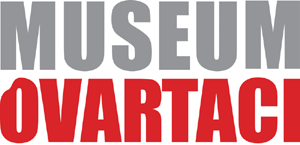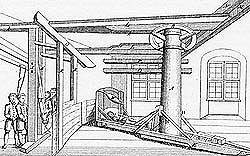
It is considered beneficial in the
treatment of mentally ill to provoke
a strong feeling of discomfort.. It is
obtained partly by provoking fear
just by seeing this machine and
knowing what it is used for and
partly by the fright of being flung
out of it and getting dangerously
injured. This machine also works
by provoking dizziness, nausea
and vomiting.
Dr. Horn. Head of "Charité",
the Berlin Asylum (1818)
Two schools of thought in psychiatry
In the 1800s there were two disputing schools of thought in psychiatry, namely the Somatics and the Psychics. The Psychics dominated before 1850, especially in Germany. They considered mental illness originating from damages to the soul. The psychological ” damage” was caused by ”giving in to passions”, – drunkenness, adultery, gambling and the like.
The methods of the Psychics
Certain physical stresses and shocks had always been used towards mentally ill to provoke them out of their delusional ideas and bring them to their senses. The Psychics developed such methods into treatments resembling torture.
These psychological methods of treatment were refined. For example, the patient could be repeatedly thrown into cold water or exposed to continuous slow dripping of cold water onto the crown of the head. Ingenious machines were in use, for example a machine that could spin a restrained patient.
The patient could also be confined in a treadmill – a hollow wheel. When the wheel was set in motion, the patient had to constantly keep his legs moving to keep him from falling. After 36 hours, even the most unruly had become quite calm.
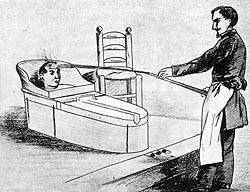
Here are shown two examples of strong
shower and
spray baths, where the
patient sits
restrained in a combined
box and
bathtub being sprayed or
doused with water.
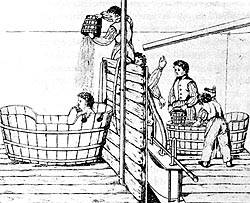
From the ashes into the fire
The German doctor Reil (1759-1813) was the founder of the psychic methods of treatment and thought these methods to be a huge improvement compared to the previous madhouses. In these bedlams the mentally ill were confined as criminals in “mad stalls”. One could say that insanity had come from the ashes and into the fire.
Reil defined the psychic treatment as a series of shocks that would scare the patient to undergo medical treatment.
The patient’s immoral mind had to be broken, so a healthy personality could emerge. Reil’s psychiatric opinion was a romantic desk philosophy that was characterized by a lack of experience with mentally ill patients.
Besides the turning bed and the other treatment machines Reil suggested ”milder” forms of treatment such as flogging with nettles and swimming in tanks with live eels. The patient’s progress should be rewarded – perhaps with intercourse!
|
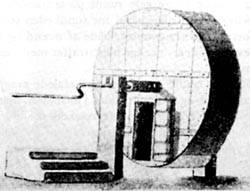
|
 |
|
The wooden mill was used to ”calm” unruly patients.
|
Another instrument of force was the grated mask.. |
The mentally ill at St. Hans.
In 1816 St. Hans Hospital in Bidstrupgaard became the first psychiatric hospital in Denmark based on treatment and cure for mentally ill.. The hospital’s first consultant was J.H. Seidelin who was dismissed in 1831 following a patient complaint. Seidelin had exaggerated the psychic treatment by punishing the patients with too hard beatings and furthermore imposing individual patients a sense of moral guilt.
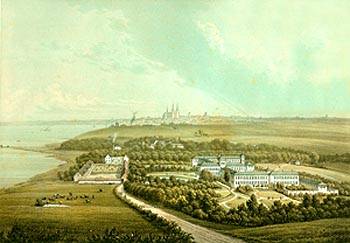
St. Hans Hospital – formerly Ladegård in Copenhagen
was moved to Bidstrup farm near Roskilde in 1816,
where it is still situated. A French-Danish fancy shop dealer
called Claudi Rosset gave his entire fortune
to the hospital when he died in 1771. Therefore, the hospital
is also called The Claudi Rosset’s Foundation.
